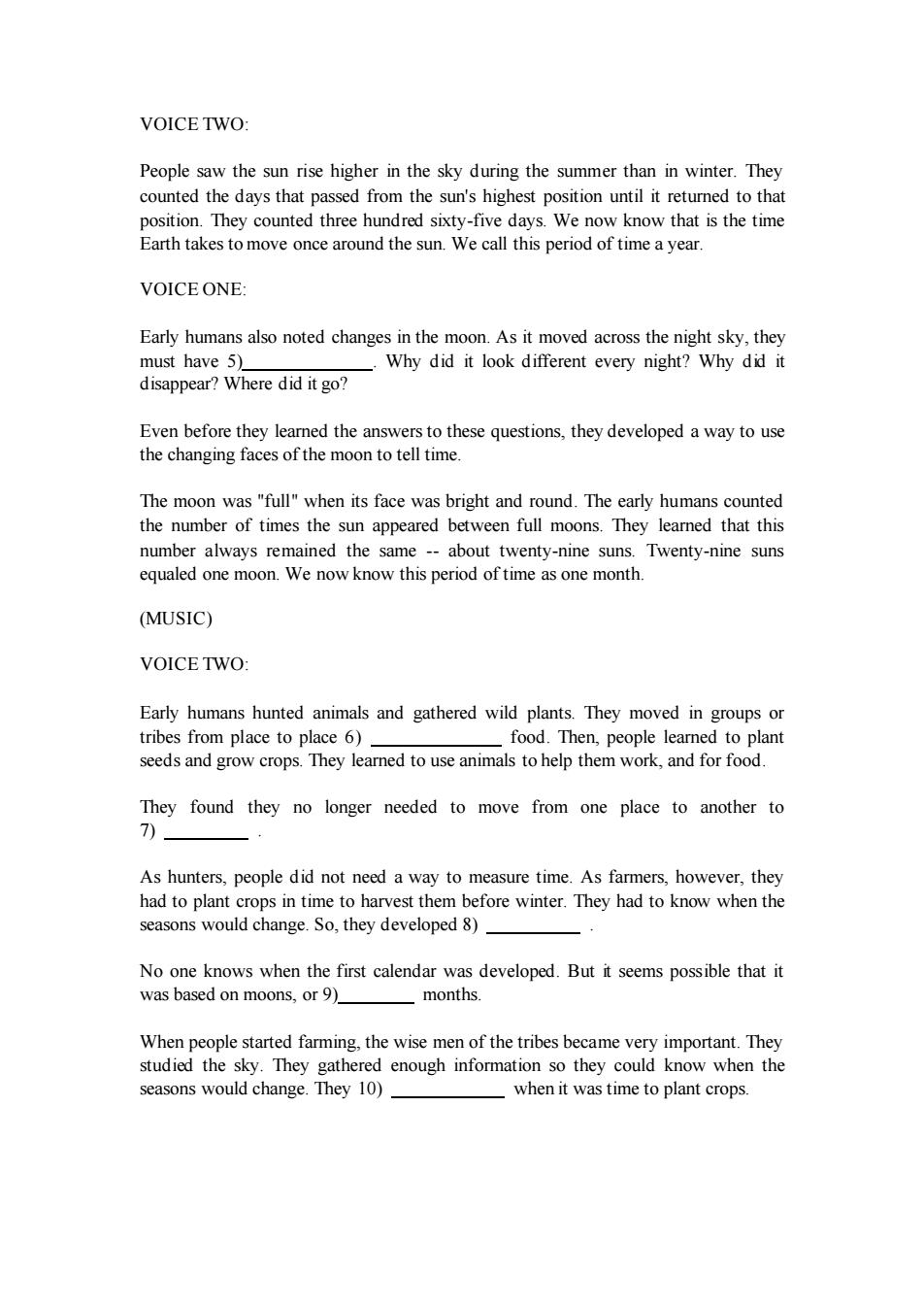正在加载图片...

VOICE TWO: People saw the sun rise higher in the sky during the summer than in winter.They counted the days that passed from the sun's highest position until it returned to that position.They counted three hundred sixty-five days.We now know that is the time Earth takes to move once around the sun.We call this period of time a year. VOICE ONE: Early humans also noted changes in the moon.As it moved across the night sky,they must have 5) _Why did it look different every night?Why did it disappear?Where did it go? Even before they learned the answers to these questions,they developed a way to use the changing faces of the moon to tell time. The moon was "full"when its face was bright and round.The early humans counted the number of times the sun appeared between full moons.They learned that this number always remained the same --about twenty-nine suns.Twenty-nine suns equaled one moon.We now know this period of time as one month. (MUSIC) VOICE TWO: Early humans hunted animals and gathered wild plants.They moved in groups or tribes from place to place 6) food.Then,people learned to plant seeds and grow crops.They learned to use animals to help them work,and for food. They found they no longer needed to move from one place to another to 7) As hunters,people did not need a way to measure time.As farmers,however,they had to plant crops in time to harvest them before winter.They had to know when the seasons would change.So,they developed 8) No one knows when the first calendar was developed.But it seems possible that it was based on moons,or 9)months. When people started farming,the wise men of the tribes became very important.They studied the sky.They gathered enough information so they could know when the seasons would change.They 10)_ when it was time to plant crops.VOICE TWO: People saw the sun rise higher in the sky during the summer than in winter. They counted the days that passed from the sun's highest position until it returned to that position. They counted three hundred sixty-five days. We now know that is the time Earth takes to move once around the sun. We call this period of time a year. VOICE ONE: Early humans also noted changes in the moon. As it moved across the night sky, they must have 5) . Why did it look different every night? Why did it disappear? Where did it go? Even before they learned the answers to these questions, they developed a way to use the changing faces of the moon to tell time. The moon was "full" when its face was bright and round. The early humans counted the number of times the sun appeared between full moons. They learned that this number always remained the same -- about twenty-nine suns. Twenty-nine suns equaled one moon. We now know this period of time as one month. (MUSIC) VOICE TWO: Early humans hunted animals and gathered wild plants. They moved in groups or tribes from place to place 6) food. Then, people learned to plant seeds and grow crops. They learned to use animals to help them work, and for food. They found they no longer needed to move from one place to another to 7) . As hunters, people did not need a way to measure time. As farmers, however, they had to plant crops in time to harvest them before winter. They had to know when the seasons would change. So, they developed 8) . No one knows when the first calendar was developed. But it seems possible that it was based on moons, or 9) months. When people started farming, the wise men of the tribes became very important. They studied the sky. They gathered enough information so they could know when the seasons would change. They 10) when it was time to plant crops